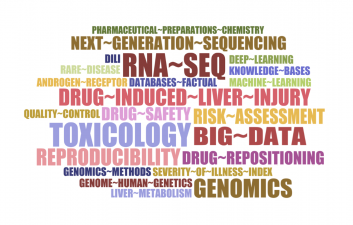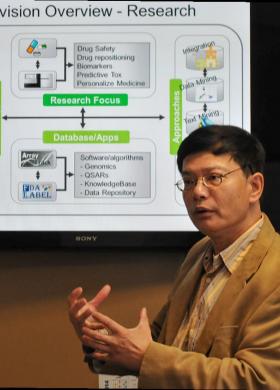NCTR Division of Bioinformatics and Biostatistics Also referred to as: DBB
Division Director: Weida Tong, Ph.D.
Artificial Intelligence for Regulatory Science Research
About the Division
Artificial Intelligence for Regulatory Science Research
The Division of Bioinformatics and Biostatistics (DBB) develops integrated bioinformatics and biostatistics capability such as Artificial Intelligence (AI) and Machine Learning (ML), molecular modeling, real world data analytics, and chemoinformatics to address increasing needs of FDA in the areas of drug safety, drug repositioning, biomarker development, precision medicine, genomics, rare diseases, endocrine disruptors, and risk assessment. Additionally, the division provides support at NCTR relating to 1) IT infrastructure, 2) data analytics for research, 3) managing commercial and in-house software tools, and 4) conducting training sessions on bioinformatics tools.
Branches Within the Division
Research efforts focus on predictive toxicology, precision medicine, biomarker development, drug safety, and drug repositioning. Most research projects are in collaboration with scientists within NCTR, across FDA product centers, and in the larger scientific community. One key endeavor of the branch is to construct knowledge bases in the specific areas of FDA’s responsibility to provide a data-driven decision-making environment for enhanced safety evaluation and precision medicine.
Conducts peer-reviewed research of statistical methods to analyze toxicological and molecular data as well as data-mining techniques for pattern identification and signal detection. The branch also provides statistical support related to FDA’s mission to protect and promote public health.
Provides critical support and enhancement to infrastructure in the areas of software and database development for research support and research management, high performance computing, systems integration, and information system-asset management and procurement.
Strengthens the division, focuses on “knowledge uptake” of the Division’s research products for regulatory application, and enables “data liberation” of regulatory data from the FDA Product Centers. Thus, facilitating regulatory-science research in the Division and increasing NCTR's linkages with FDA Product Centers.
Scientific and Educational Outreach
The division’s mission is to ensure that its activities relate to FDA’s review process, its work with product centers continue to be strengthened, and its capabilities evolve to meet the current and future needs of FDA. In 2020, approximately 30 peer-reviewed articles were published despite the adversities caused by the pandemic. The division focused on these areas of research in 2020:
- COVID-19─repurposing existing drugs for potential therapeutic options with bioinformatics which is funded by the FDA Medical Counter Measure Initiatives (MCMi).
- AI─developing Natural Language Processing for FDA documents to support FDA review.
- Hepatotoxicity─supporting the FDA review process with in-house computational models for drug-induced liver injury (DILI). The division is equipping itself to better address emerging technologies such as AI.
This directional shift is prudent to prepare FDA for technological advances in this area now and in the future.
Support
The division has been active in supporting the AI and IT infrastructure both in-house at NCTR and for several FDA product centers, such as the longstanding collaboration between NCTR and CDER to improve drug safety. This collaboration has yielded several tools such as Smart Templates, FDALabel, and DASH that have been beneficial for the FDA regulatory mission and regulatory science research. The division continues to develop and maintain bioinformatic tools such as ArrayTrack, FDALabel, and Rule-of-Two (RO2).
2020 Select Accomplishments
- Breakthrough Therapy Designation (BTD) system
- Text mining study of Office of New Drugs (OND) regulatory documents (Meeting Minutes)
- Conducted studies under the ongoing project called Sequencing Quality Control Phase 2 (SEQC2); an NCTR-led consortium effort to assess technical performance and application of emerging technologies for safety evaluation and clinical application. Papers about studies in the following areas were scheduled for submission in 2020:
- Cancer genomics using whole-genome sequencing
- Cancer genomics using target-gene sequencing
- Reproducibility of whole-genome sequencing
- Epigenomics
- DILIst, using data from the NCTR-developed Liver Toxicity Knowledge Base, classified about 1,300 drugs known to cause human drug-induced liver injury (DILI)
- Led a CAMDA (Critical Assessment of Massive Data Analysis – platform to evaluate big data analytics using a crowdsourcing challenge mechanism) Challenge for artificial intelligence/machine learning to predict DILI with genomics data
- SS Pfizer Paper of the Year Award in the Computational Toxicology Section, Society of Toxicology, “Integrating Adverse Outcome Pathways (AOPs) and High Throughput In Vitro Assays for Better Risk Evaluations, a Study with Drug-Induced Liver Injury (DILI)."
- Developed a novel deep-learning approach to identify drug labeling through integrated analysis of image and text embedding. This approach has the potential to enable efficient and accurate product recognition through digital visual screening of product packages. BMC Medical Informatics and Decision Making.
Select Projects in 2021
- Opioid Agonists/Antagonists Knowledgebase (OAK) to Assist Review and Development of Analgesic Products for Pain Management and Opioid Use Disorder Treatment
- Artificial Intelligence (AI)-Powered Drug Repositioning for Treating COVID-19
- Development of a Comprehensive Open Access Molecules with Androgenic Activity Resource (MAAR) to Facilitate Risk Assessment of Chemicals
- DeepDILI: Benchmarking and Comparing Computational and Genomic Predictive Methods for Toxicity for Drug-Induced Liver Injury (DILI) Using AI-Based Methods
- Bioinformatics and Computational Chemistry Supports to CDER Reviewers
- An Integrative Model for Drug-Induced Liver Injury with High Throughput Assays and Real-World Evidence
- Development of a Reproducible Workflow to Analyze Real-World Incomplete or Uncertain qPCR Data
- Advanced Semantic Indexing and Searching for Tobacco Applications (ASSIST4Tobacco)
- The Database of Pharmacogenomic Information in Ethnic Minority Populations (dbPGxEMP)
Resources for You
- NCTR Grand Rounds: "Artificial Intelligence for Regulatory Science Research" (Presentation recorded in Adobe Connect on May 14, 2020)
- Annual Reports
- Bioinformatics Tools
- Meet the Principal Investigators
Contact Us
- NCTR Bioinformatics Support
- National Center for Toxicological Research
Food and Drug Administration
3900 NCTR Rd
Jefferson, AR 72079
-
Hours Available
- [email protected]
- (870) 543-7538


